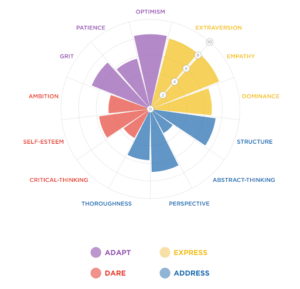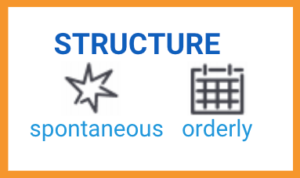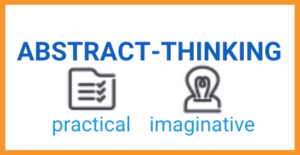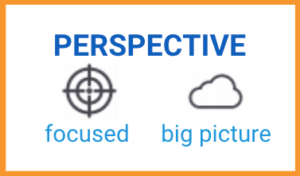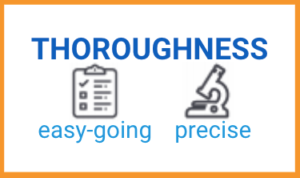Unpacking Your Personality: How Do You Address Tasks and Projects?
Even if you think that you know a lot about yourself and your personality, it is always good to be open to an unbiased opinion about how you respond to the world around you. This can include how you interact with others in class or during meetings, the way you handle pressure of deadlines or tests, and how you organize projects. Taking a personality or soft skills assessment, like MyPrint, can help to uncover strengths you were unaware of or reinforce what you already knew.
What are your strengths and how do you use them on a daily basis? Are there any skills that you are missing or want to improve upon? These are just a couple of the questions that you can ask yourself to get the most out of your soft skills assessment results.
Understand how you approach tasks and projects.
Personality and soft skill assessments help us understand ourselves better by using basic psychological models, such as the Big Five Model of personality. At Talentoday, we have organized our personality dimensions into four groups, called the personality axes, to show how understanding your different traits will empower you to navigate your day-to-day life using science and technology. The four personality axes in MyPrint help us understand how we interact with other people (“Express” - yellow), our tasks and projects (“Address” - blue), ourselves (“Dare” - red), and our environment (“Adapt” - purple).
The Address section of the personality axes is helpful for understanding the way someone approaches issues and undertakes their tasks or projects. This can be beneficial when starting a fresh school year or new job, or if you’re just generally interested in making meaningful improvements in your day-to-day responsibilities.
The four personality dimensions that make up the Address axis are: Structure, Abstract-Thinking, Perspective, and Thoroughness. Being on the high or low end of each of these dimensions does not make you better or worse at planning or conducting your tasks; rather, it helps you to understand your strength in each of those areas so that you can lean into the things you are good at, while pinpointing the areas in which you may want to improve. Remember, you can always leverage an assessment to help understand your personality with an unbiased, scientific approach.
Structure
The two ends of the structure dimension are Spontaneous and Orderly.
If you are a spontaneous person, then you are naturally intuitive. You like to stay flexible in your schedule by avoiding planning things too far in advance, and you often leave a lot of room for improvisation in your working methods. If you are finding that you need a little bit more structure when organizing your week, start by writing down your most important objectives, and do your best to accomplish those even if other things come your way.
On the other end of the structure dimension are the orderly people. If you are orderly, then you are very organized and show no tolerance of ambiguity in your work. You always plan your tasks and projects well in advance and rarely deviate from your schedule. Although this may seem like it is the best way to organize and plan, there are certain times when flexibility is beneficial. When creating your to-do list, determine what is an absolute priority and what you can be flexible with; stay open to opportunities that may come your way.
Abstract-Thinking
The two ends of the abstract-thinking dimension are Practical and Imaginative.
If you are a practical person, you are realistic and don’t like to waste too much time wondering why things are the way they are. You rely on concrete examples to solve issues. If you find yourself stuck when working on an assignment, try to tap into your imagination a little bit. Think of some out-of-the-box ideas for your projects that you might not normally entertain.
On the other end of the abstract-thinking dimension are the imaginative people. If you are imaginative, you often conceptualize problems and try different approaches in order to solve them in the most relevant, but not always the most realistic way. Imaginative people are very creative, but if you find yourself unable to solve an issue, try to only look at what resources and solutions that you actually have available.
Perspective
The two ends of the perspective dimension are Focused and Big Picture.
If you are a focused person, then you are action-oriented. You probably prefer to concentrate on achieving short-term results, rather than spending time to anticipate their future implications. While it is beneficial to focus on those immediate outcomes, there is also a lot to be learned when looking at the long-term impacts of what you are doing. When learning something new or working on a project, think about the relevance and meaning it will have a few years into the future.
The other end of the perspective scale is where the big picture thinkers are. If you are big pictured, you are naturally thoughtful in your work. You will anticipate the long-term consequences of what you are doing as much as possible to have a clear vision of the final outcomes. At times it can be exhausting to think about the future when there is so much uncertainty. If you find yourself being overwhelmed by this, try to focus on the pieces of a project that you can immediately impact regardless of their long-term implications.
Thoroughness
The two ends of the thoroughness dimension are Easy-Going and Precise.
If you are an easy-going person, you are typically tolerant of imperfections. You prefer to value your productivity at work by focusing on the bottom-line, rather than dwelling on every little detail. Having a quantity-centered approach to your work can be beneficial at times, but it is always good to be cognizant of which projects might require a little more attention to detail. When these types of projects come up, schedule some extra review time into the end of your day!
On the other end of the thoroughness dimension we have the precise folks. If you are a precise person, you are naturally diligent. You set high-quality standards for your work and spend time to refine it. However, sometimes it is hard to turn off the ‘perfectionist’ switch. Determine which areas of your work need the extra attention to details, and try to only spend the necessary time on the rest.
Putting it all into action.
Now that you know a little more about the personality traits used to understand how you take on tasks and projects, as part of MyPrint’s Address dimension, it is time for you to take action. If you haven’t taken a MyPrint just yet, you can take it for free in just 25 minutes! There are many other helpful insights besides the ones we discussed here, such as what motivates you, or getting a better understanding of your professional behaviors. Take a look at which soft skill strengths you have and what motivates you, and use that information to help you improve as you take on your next project!
Why Upskilling is Crucial for Hybrid Teams

There were a lot of things I didn’t know I could do before COVID-19 upended the way we live and work. For example, I already knew my way around the kitchen, but I had no idea I could make tasty banana bread! I also learned how to cook a spicy jambalaya, brew my own beer and, when I wasn’t eating or drinking, I figured out how to use a 35mm film camera to expand upon my interest in photography. In my home life, I would call these achievements “little victories.” Little did I know that, were I to do the same sort of expanding of my talents in the workplace, it would be known as “upskilling.”
Upskilling is the process of using training and education to deepen an employees’ abilities within their area of expertise. This is slightly different from reskilling, which is when an employee is trained on an entirely new skill set in order to move into a different role. Instead, upskilling is all about building upon an employee’s existing skills in hopes of enhancing their impact on an organization.
While my personal upskilling may not have major implications for the workplace (even if some morning meetings are greatly improved by the addition of banana bread), upskilling has the potential to reshape the way organizations recruit and develop talent – especially as teams embrace hybrid work models.
The Skills Gap Continues to Expand
As the modern workplace undergoes unprecedented changes, existing skills gaps across all industries are widening. While employees may have entered into the workforce with skills that were in high demand at the time, the rate of digital transformation has increased sharply in response to the COVID-19 pandemic, leaving many of these employees behind. According to McKinsey & Company, 87 percent of companies say they have skills gaps or expect to within a few years. Jobs are changing fast, and employers and employees are struggling to keep up.
There are a few options at organizations’ disposal for dealing with these gaps in needed competencies. In less competitive hiring markets, one appealing course of action would be to bring in new talent to fit the needs. However, today’s recruiting landscape is characterized by a dwindling supply of talent and an aggressive influx of demand from employers. These conditions have forced many employers to look inwards when determining how to address their skills gaps in the years ahead.
Employees are Looking for a Change
To exacerbate the problem even further, this expanding skills gap comes at a time when workers are beginning to quit jobs at extraordinary levels. In April 2021, the number of employees leaving their companies spiked to approximately 4 million according to the Bureau of Labor Statistics (BLS), leading many to refer to the phenomenon as, “The Great Resignation.”
In truth, does anyone ever really want to be forced to find a new job? In the same way that employers would rather retain talent than search for replacements, employees are hoping for reasons to stay at their current organizations before making a drastic move. Take the results of a recent PwC survey into consideration. Their findings show that the majority of workers are open to change, citing that 40 percent of respondents successfully improved their digital skills during the pandemic and over 90 percent of those who adapted to remote work would prefer to continue working in this style of environment. On top of that, 77 percent of workers are ready to learn new skills.
The issue is not a lack of willingness to learn on the side of employees but, rather, the lack of opportunities for upskilling offered by employers. However, if organizations are serious about closing their skills gap and retaining employees in the face of an explosion of resignations, it’s time to make learning and development programs a real priority.
Make Upskilling a Priority
While employers seem to recognize the problem they face, there remains a gap between this recognition and an understanding of how to address the underlying causes. According to a 2021 survey conducted by Gartner, 68 percent of HR leaders cited building critical skills as a top priority. However, more than 30 percent of the same leaders say that they don’t know what skills gap their employees have, how to effectively integrate learning into employee workflows or can’t create skill development solutions fast enough to meet evolving skill needs. In short, employers know there are skills gaps to address, but are uncertain where they lie or how to fix them.
The way forward is two-pronged, based first on assessment then solidified with commitment:
- Assessment: First and foremost, organizations need to utilize tools to empower them to better evaluate their candidates and employees. Knowing the current capabilities of a team is important, but identifying the potential for growth can be critical. While necessary technical skills can be assessed through traditional means, such as verifying education and certification backgrounds, this must be coupled with a deeper understanding of soft skills. Scientifically-based soft skills assessments can provide insight into an individual’s capacity to upskill into a role over time.
- Commitment: Once the workforce has been properly assessed, organizations must then approach upskilling differently than standard onboarding and other job-specific training opportunities. Instead, upskilling opportunities must be treated like the valuable benefits they are. As noted in Fast Company, “For the top tier of talent, upskilling is emerging as a must-have employee benefit, like a retirement saving plan, employer subsidized health care, or paid time off.” In other words, these education programs cannot be haphazardly inserted into existing workflows. Rather, time and space must be set aside for employees to truly feel as though upskilling is a top priority.
As the way we work continues to change, teams are struggling to keep up. However, by devoting time and effort to upskilling programs, there are win-win solutions available for employers and employees alike.
Are you ready to evaluate your team’s soft skills to determine upskilling opportunities? Discover the powerful science of people analytics that drives MyPrint by clicking here.



